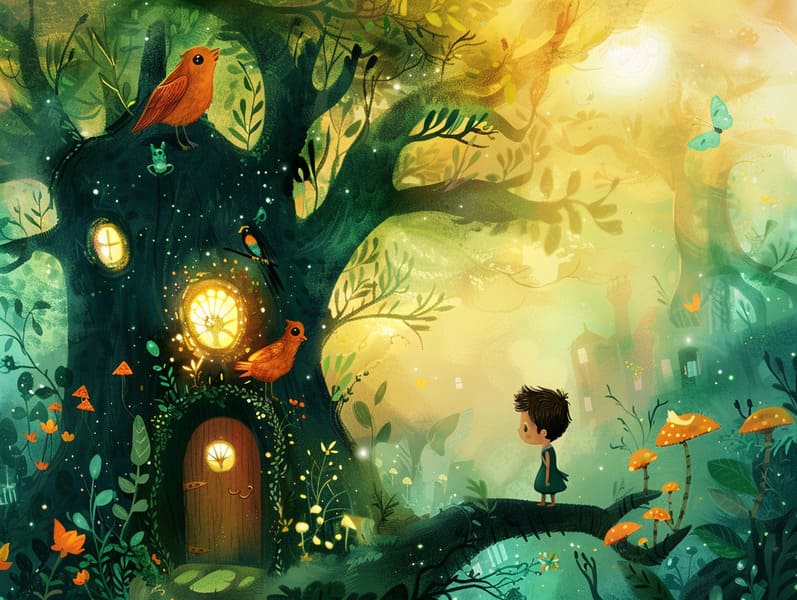
Vintage fairy tales have timeless appeal. These narratives have been shared from one generation to the next far before they were ever recorded. They developed from a variety of backgrounds, including African traditions. They were initially told among grown-ups, often carrying themes and messages related to the societal norms and beliefs of the time.
The Brothers Grimm, Jacob and Wilhelm Grimm, were among the first to compile and release many of these beloved tales. Their published works, "Grimm's Fairy Stories," included tales like "Ashenputtel," "Hansel and Grethel," and "Snow White," which have since become mainstays in the world of iconic fairy tales. Similarly, Andersen's fanciful fairy tales, such as "The Little Mermaid," and "The Little Duckling," have captured hearts worldwide, ensuring their place in the pantheon of famous fairy tales.
Despite their age, traditional fairy tales remain as significant as ever, especially as kids' bedtime tales. These charming stories are now available in numerous formats, including vibrantly illustrated books, fantastical animations, and web-based fairy tales.
Their enduring popularity can be connected to several magical reasons:
Important Morals: Traditional fairy tales often teach important moral lessons. Narratives like "The Wolf and the Liar" teach the importance of truth, while "The Race of the Tortoise and the Hare" underline the traits of resolve and modesty. These narratives offer children clear distinctions between ethical and unethical, building their moral compass in a tender yet important way.
Compassion and Knowledge: Classic fairy tales frequently include protagonists facing obstacles and hardships, stimulating children to connect with their struggles and champion their triumphs. For instance, "Beauty and Her Beast" shows us the virtue of looking beyond appearances to comprehend the inner spirit of a being, developing understanding and recognition.
Cultural Perception: Many ancient fairy tales are infused with the cultural contexts from which they came. Learning from these fairy tales can provide delightful insights into different societies, nurturing a sense of global respect and discernment.
Inventiveness and Fantasy: The magical elements in traditional fairy tales—magical beings—enliven children’s innovations. These tales guide readers to extraordinary realms, generating fantasy dreams and a sense of curiosity that continues a lifetime.
Old fairy tales are not only enchanting but also edifying. They act as bewitching tools in enhancing various mental and emotional abilities in young readers. When timeless fairy tales are read aloud, they strengthen speaking abilities by showing new language items and complicated sentence structures. This practice also promotes hearing perception and focus, as children pay close attention, looking forward to see what happens next.
Furthermore, debating the themes and characters of timeless fairy tales can cultivate evaluative skills and problem-solving abilities. Young readers learn to discern patterns, expect results, and understand cause and effect. These examinations also encourage the young verbalize their thoughts and feelings, contributing to their emotional intelligence.
In today’s technological era, the existence of online fairy tales has made these tales more available than ever. Digital sites and applications share large libraries of ancient fairy tales that can be viewed or played anytime, anywhere. Fairy tales told out loud are particularly common, supplying an fun way for young readers to relish these magical stories. Sound books and read-to-me videos take characters and settings to life, often supported by captivating music and background music that enrich the narrative journey.
The lasting appeal of timeless fairy tales lies in their ability to adjust to current times while continuing with their underlying messages. Contemporary retellings of these tales often show more inclusive protagonists and modern settings, making them relevant to today’s audience. However, the central morals of daring, benevolence, and rightness remain unchanged, continuing to influence audiences of all ages.
Fairy tales also offer a sense of peace and predictability. They impart upon a well-ordered narrative with a evident beginning, middle, and end, often coming to a close with the resolution of conflicts and the triumph of goodness over badness. This foreseeability can be placating for the young, sharing a sense of unwaveringness in an unstable world.
Classic fairy tales continue to entrance and guide new generations, maintaining their majesty and relevance in modern society. As bedtime stories for kids, they highlight a perfect blend of wonder and wisdom, cultivating moral values, empathy, and creativity. The existence of web-based fairy tales and the in demand status of fairy tales voiced ratify that these old tales remain available to new generations.
By upholding and sharing these narratives, we continue to extol the rich tapestry of fables and cultural heritage. Whether website you are browsing a gorgeously illustrated book, browsing a internet collection, or listening via an audiobook, the majesty of ancient fairy tales is always within reach. These narratives highlight of the perpetual force of stories and its ability to tie us across centuries and lands.
No matter if you are viewing a artistically illustrated book, exploring a web-based collection, or listening through an voice book, the wonder of bedtime fairy tales is always within reach.
These narratives demonstrate of the lasting power of fairy tales and its ability to connect us across time and space, forming a connection that fascinates and enlightens alike.